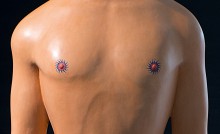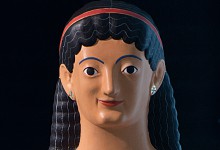My pupil Clarissa Blume earned her doctorate with an extensive thesis on the colouration of Hellenistic marble sculpture. Within that context, working with the physicist and conservator of the Bayerische Verwaltung der staatlichen Schlösser, Gärten und Seen, she carried out an in-depth investigation of paint vestiges on the Frankfurt muses and presented the results in a drawn reconstruction. The Liebieghaus responded to this initiative by scanning one of the muses and printing out a three-dimensional copy in the original size in order to paint it in the original colours. To this end, a number of further investigations were necessary to answer all the questions raised by a same-size copy. The scientific examinations established very audacious hues of the kind typical of Late Hellenism. A vivid pink and a vibrant light blue—in other words madder lake and Egyptian blue—dominate the colour scheme.
At the very beginning of last year, we met with colleagues from the Metropolitan Museum of Art in front of the so-called New York kouros. This striking archaic marble figure of a naked young man had been purchased in the early twentieth century. It exhibits a wealth of surviving traces of paint which have always been treated with the greatest care. In collaboration with Dr Ulrike Koch-Brinkmann, Dr Heinrich Piening of Bayerische Schlösserverwaltung succeeded in determining the colours of the body and jewellery elements. The naked skin was painted an orange-brown ochre, the nipples a red ochre mixed with madder lake, the hairband and neckband a bright red ochre. Numerous traces of a blackish brown iron oxide were detected on the hair of the head.
The behaviour of the marble surface under ultraviolet radiation moreover indicated that the eyebrows and the artfully shaved pubic hair were painted an azurite blue. The preliminary incisions of the body hair, stylized as sun wheels around the nipples, were photographically documented and evaluated. These investigation results coalesce with insights I have obtained over the past thirty-five years from the many other marble kouroi in the collections of the world. On this basis, a colour reconstruction was carried out on a plaster cast. We are still impressed today by the enigmatically enlivening effect of the polychromy.








